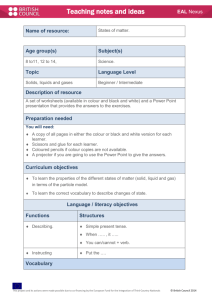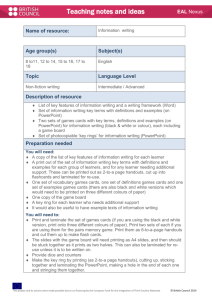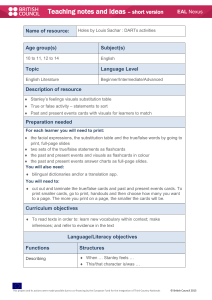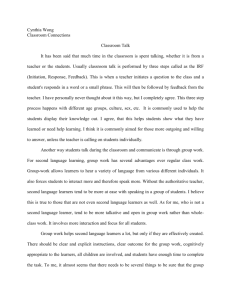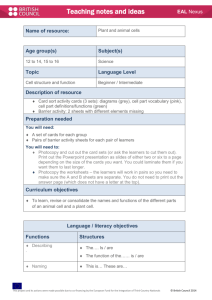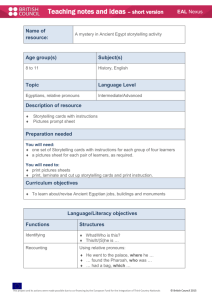Extended version
advertisement
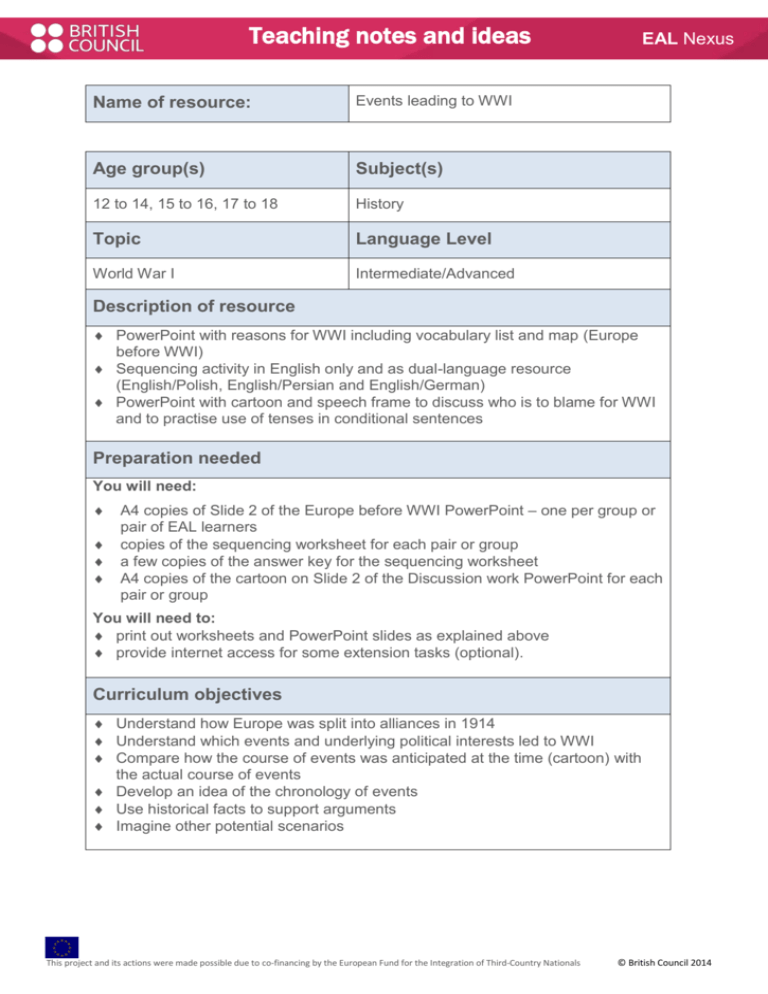
Teaching notes and ideas Name of resource: Events leading to WWI Age group(s) Subject(s) 12 to 14, 15 to 16, 17 to 18 History Topic Language Level World War I Intermediate/Advanced EAL Nexus Description of resource PowerPoint with reasons for WWI including vocabulary list and map (Europe before WWI) Sequencing activity in English only and as dual-language resource (English/Polish, English/Persian and English/German) PowerPoint with cartoon and speech frame to discuss who is to blame for WWI and to practise use of tenses in conditional sentences Preparation needed You will need: A4 copies of Slide 2 of the Europe before WWI PowerPoint – one per group or pair of EAL learners copies of the sequencing worksheet for each pair or group a few copies of the answer key for the sequencing worksheet A4 copies of the cartoon on Slide 2 of the Discussion work PowerPoint for each pair or group You will need to: print out worksheets and PowerPoint slides as explained above provide internet access for some extension tasks (optional). Curriculum objectives Understand how Europe was split into alliances in 1914 Understand which events and underlying political interests led to WWI Compare how the course of events was anticipated at the time (cartoon) with the actual course of events Develop an idea of the chronology of events Use historical facts to support arguments Imagine other potential scenarios This project and its actions were made possible due to co-financing by the European Fund for the Integration of Third-Country Nationals © British Council 2014 EAL Nexus Language/Literacy objectives Functions Structures Describing key events leading to WWI Short, simple sentences in the simple past Arguing Phrases to introduce one’s opinion Predicting what will happen under given conditions if sentences (type 1): simple present in the ifclause and will future in the main clause Expressing hypothetical conditions that cannot be fulfilled any longer if sentences (type 3): past perfect in the if-clause and conditional perfect in the main clause (modelled) More information on conditional clauses can be found here: https://learnenglish.britishcouncil.org/en/grammarreference/conditionals-1 http://learnenglish.britishcouncil.org/en/grammarreference/conditionals-2 http://learnenglish.britishcouncil.org/en/englishgrammar/verbs/verbs-time-clauses-and-if-clauses Vocabulary Political terms: war, triple, raw materials, colony, Kaiser, fleet, alliance, heir, treaty, withdraw, invade Phrases to present arguments: There is no doubt that …, In my opinion …, I think …, To my mind …, I think it is fair to say …, Looking at … I come to the conclusion that … This resource could be used: whole class one to one or small group independent learning This project and its actions were made possible due to co-financing by the European Fund for the Integration of Third-Country Nationals © British Council 2014 EAL Nexus Ideas for using the resource What to do Using the first PowerPoint: Europe before World War I Hand out copies of Slide 2 headed ‘Words you need to know’ to EAL learners. Alternatively, play a matching game. For this you cut up the words and definitions into individual strips (to make this easier, you may want to print the slide in A3). You should have 11 words and 11 definitions. Give one slip (either definition or word) to each learner (or pair of learners, which is an opportunity to pair EAL learners with good models of English). Ask the learners to move around the room and find their ‘partner’, i.e. match words and their definitions. The words and definitions can then be displayed in the classroom. Explain that all these words are important for the topic ‘Events that led to WW I’. Show the map on Slide 3 to visualise the European borders. Ask if learners spot differences to a 21st-century map of Europe. Mention important differences: - no Poland (split between Austria-Hungary) - Hungary, Czech Republic, Slovakia as well as parts of some Balkan States belong to Austria-Hungary - borders of Balkan States are different from today - Russia includes Baltic States, Ukraine and Belarus - Ottoman Empire covers today’s Turkey and other Middle Eastern countries. Ask learners for ideas why different colours are used. Refer to the title of the slide. Show Slides 4–11. Explain any historical points. Learners then consolidate the events leading to WWI using the ‘sequencing exercise’ worksheet. This provides an opportunity for collaborative group work as the sequencing task could be done in pairs or small groups; discussion should be conducted in small groups and then shared with the whole class. Using the second PowerPoint: Discussion work Show Slide 2 with the cartoon on. Explain that it was published in an American newspaper in July 1914. Discuss what the ‘chain of friendship’ means in terms of war. Point out that the soldiers in the cartoon all only say half a sentence. Use Slide 3 to finish the sentences in the speech bubbles cartoon. You could ask the learners to write new speech bubbles on Post-it notes and display the new version of the cartoon in the classroom. To indicate that these threats are made before WWI starts and the consequences are therefore in the future, choose a heading such as ‘Europe in July 1914’. The speaking frame on Slide 5 can be used to prepare short presentations in answer to the question ‘Who is to blame for WWI?’ Make Slides 8 to 11 of the first PowerPoint available as a handout so that learners can find reasons. Explain that although we cannot change the events in 1914 any longer, we can imagine This project and its actions were made possible due to co-financing by the European Fund for the Integration of Third-Country Nationals © British Council 2014 EAL Nexus that they were different. This could form the basis of a group discussion and then the presentation can be prepared as a group. You may want to give some examples and focus on the grammar to express this imaginary situation using Slides 6, 8 and 9 (opportunity for integrating grammar into topic). There is an opportunity for a speaking/listening activity on hypothetical conditions with an if-chain game. One learner or the teacher starts with one if-sentence, the idea in the main sentence is then used for a new if-sentence by the next speaker and so forth (see Slide 8). Other ideas for making the best use of this resource For EAL learners who are literate in Polish, Persian or German, there are bilingual versions of the sequencing worksheet so that they can make use of their first language. All EAL learners should have access to a bilingual dictionary or monolingual learner’s dictionary. Extension activities Extension tasks Slides 4–8 from the Europe before WWI PowerPoint, which will provide an opportunity for exploratory talk if done in pairs or groups: 1. Research the modern-day names and boundaries of the countries in the Triple Alliance and Triple Entente and find out if today’s flag is the same or different. (Requirements: atlases and internet access) 2. Research the family relationships between George V, Nicolai III and Wilhelm II. 3. Investigate the raw materials further (e.g. copper, cotton, rubber, tea, tin). Learners could be asked to write more ‘if-sentences type 3’ according to the model. Each learner could be recorded (e.g. on a tablet or digital recorder); learners could then transcribe each other’s sentences and correct them, especially with regard to correct use of tenses. (This is likely to be a challenge for EAL learners and native speakers alike.) This project and its actions were made possible due to co-financing by the European Fund for the Integration of Third-Country Nationals © British Council 2014
